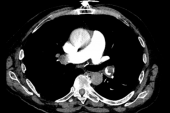FlowTriever Safe, Effective for Acute PE in Expanded FLASH Results
“Clearly we’re now setting the stage for more-invasive therapy for . . . intermediate-risk PE,” Ehtisham Mahmud says.

For patients with intermediate- or high-risk pulmonary embolism (PE), removing the blockage with the FlowTriever percutaneous mechanical thrombectomy system (Inari Medical) is both safe and effective, according to an expanded interim analysis of the FLASH registry.
The procedure provided immediate hemodynamic benefits while patients were still on the table, with a 23% reduction in mean pulmonary artery pressure (mPAP) and an 18% increase in cardiac index among those with low values at baseline (P < 0.0001 for both), Catalin Toma, MD (University of Pittsburgh Medical Center, PA), reported as a “Key Abstract” online as part of an sneak peek at TCT 2021, which starts later this week.
“This rapid impact in hemodynamics is unique to thrombectomy and, when applied early, may be the key to interrupting the potential clinical deterioration and [shortening] the hospital stay,” Toma said, noting that “this was achieved with a relatively rapid procedure.”
Mortality rates for patients with high-risk (massive) and intermediate-risk (submassive) PE are still high, despite the use of newer anticoagulants, Toma noted. While thrombolytic therapy has long been the mainstay of treatment, it is associated with significant bleeding risks.
During a discussion following Toma’s presentation, Ehtisham Mahmud, MD (Sulpizio Cardiovascular Center at UC San Diego Health, La Jolla, CA), called these “very impressive data,” adding that “clearly we’re now setting the stage for more-invasive therapy for the treatment of intermediate-risk PE.”
First 500 FLASH Patients
The FlowTriever system, which consists of three self-expanding nitinol mesh disks to engage with the clot and deliver it to a large-bore aspiration catheter for extraction, is the first mechanical thrombectomy system designed specifically for the treatment of PE. It was cleared by the US Food and Drug Administration for this purpose in 2018 based on the results of the FLARE investigational device exemption trial.
The FLASH registry was created to evaluate use of the FlowTriever in a real-world patient population with a broader risk profile than that included in FLARE. Investigators plan to enroll 1,000 patients with intermediate- or high-risk PE. Toma reported on the first 230 patients last year and on the first 500 patients (mean age 61 years; 52.8% men) in this most-recent presentation for TCT 2021, which also included follow-up out to 6 months. The vast majority of patients (93.8%) had intermediate-risk PE, and the rest had high-risk PE.
Looking at the procedure itself, median device time was 43 minutes, with only two patients having access-site complications. One of the drawbacks of the technology is blood loss, Toma said, and patients in this cohort lost a median of 260 mL. But this is only of “historical interest” because there are now ways to filter the blood and return it to the patient, he added. “This is no longer a major issue.” Most patients (63.1%) did not require an ICU stay after the procedure.
The primary endpoint was major adverse events (a composite of device-related mortality, major bleeding, and intraprocedural/procedure-related events) through 48 hours. This endpoint was met by seven patients (1.4%), including six with major bleeds and one with a procedure-related event (clinical deterioration requiring support with extracorporeal membrane oxygenation).
Mortality risk was low at 48 hours (0.2%), 30 days (1.1%), and 6 months (4.9%), Toma reported.
Along with the immediate hemodynamic improvements, the FlowTriever procedure also was associated with significant reductions in heart rate (from 101.6 bpm at baseline to 90.1 bpm after the procedure to 87.1 bpm at 48 hours) and the need for supplemental oxygen—the proportion of patients on room air increased from 11% at baseline to 71% at 48 hours.
Echocardiographic measures of RV function largely normalized by 48 hours. Within 6 months, there were substantial reductions in dyspnea and in the frequency of complaints score, part of the PE-specific quality-of-life questionnaire.
One of the most-feared complications of PE is the development of chronic thromboembolic pulmonary hypertension (CTEPH), Toma said, reporting that only four patients (1.6%) in this analysis received the diagnosis by 6 months. Another four patients (1.5%) developed the milder form of the condition called chronic thromboembolic disease (CTED). These conditions, Toma noted, may not have been related to the initial PE event and may have been preexisting.
Mahmud pointed out that the roughly 3% rate of CTEPH/CTED seen in this study is consistent with population-based studies, and expressed skepticism that the risks could be attenuated with any type of acute PE treatment.
Awaiting Randomized Data
Speaking with TCTMD, Mahmud said the results provide a “clear signal of efficacy and safety” with the FlowTriever system. The most-important indications of efficacy, he specified, were the immediate reduction in mPAP and the improvement in RV/LV ratio.
To me, it’s not about A device versus B device. It’s more about effective thrombectomy. Ehtisham Mahmud
The study “provides us fantastic data heading into this randomized trial against catheter-directed therapy,” he commented, referring to the PEERLESS trial recently announced by Inari Medical. The trial will randomize up to 700 patients with intermediate-risk PE the US and Europe to thrombectomy with the FlowTriever system or catheter-directed thrombolysis.
The randomized data will be important because there are some who argue that conservative therapy—ie, heparin alone—is adequate for this group of patients, Mahmud said. “I think [the FLASH registry], on the background of other similar registries with various devices, is favoring moving towards a catheter-directed, thrombectomy-directed strategy, but it will not, I think, take over as the primary approach for these patients until we have some randomized data.”
The trial will also help determine whether thrombectomy improves resource use by shortening the hospital stay. Registry studies suggest that will be the case, “but all of those things are being compared against historical controls, and I think that’s why the randomized trial is critical,” he commented.
While awaiting those trial results, centers will continue using systems like the FlowTriever to treat patients, and Mahmud provided some advice on selecting the best candidates. Among the larger group of patients with intermediate-risk PE, those with more comorbidities and a greater degree of hemodynamic instability are more likely to benefit from some sort of thrombectomy, with those at lower risk continuing to be managed conservatively with anticoagulation, he said.
As for how to choose between different thrombectomy systems, “you have to look at how effective any individual device is in thrombectomy, what the ease of use is, how big the catheter delivery system is, and how comfortable the operators are who are going to take care of these patients,” Mahmud said. “So there’s a lot of these other factors that come into play. To me, it’s not about A device versus B device. It’s more about effective thrombectomy, and whichever device can get you the greatest and most effective thrombectomy acutely is likely going to be the most efficacious.”
Todd Neale is the Associate News Editor for TCTMD and a Senior Medical Journalist. He got his start in journalism at …
Read Full BioSources
Toma C. Acute and long-term improvements following FlowTriever mechanical thrombectomy in pulmonary embolism patients: six-month results from the FLASH registry. Presented at: TCT 2021. October 27, 2021.
Disclosures
- Toma reports no relevant conflicts of interest.
- Mahmud reports personal and/or institutional payments related to consulting or speaking from Abiomed and Medtronic, as well as institutional grant support/research contracts from CSI, Corindus, and Edwards Lifesciences.





Comments